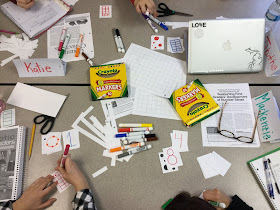Welcome to the 133rd installment of the Playful Math Carnival.
 133 is the 6th octagonal number. How many carnivals until the 7th octagonal? What kind of pattern do the 6th polygonal numbers make? (Play with some figural number GeoGebra.)
133 is the 6th octagonal number. How many carnivals until the 7th octagonal? What kind of pattern do the 6th polygonal numbers make? (Play with some figural number GeoGebra.) 133 is also semiprime - the product of two prime factors. (Which two?) What is the next semiprime number? 133 is also a Harshad (aka Niven) number, a number divisible by the sum of its digits. It's an unusual stretch where 3 of four consecutive integers are Harshad - which are the other two? There's also a new to me fact: 133 is the number of partitions of 55 into distinct odd parts, which seems equivalent to the number of symmetric Ferrers graphs with 55 nodes. I haven't made sense of this yet, though! 133 is happy in base 10, so a good number for this holiday edition.
133 is also semiprime - the product of two prime factors. (Which two?) What is the next semiprime number? 133 is also a Harshad (aka Niven) number, a number divisible by the sum of its digits. It's an unusual stretch where 3 of four consecutive integers are Harshad - which are the other two? There's also a new to me fact: 133 is the number of partitions of 55 into distinct odd parts, which seems equivalent to the number of symmetric Ferrers graphs with 55 nodes. I haven't made sense of this yet, though! 133 is happy in base 10, so a good number for this holiday edition.Last fact and shout out to Megan Schmidt: 133 is a square spiral corner number! Is that connected to any of the patterns discussed above?
Literal math playing...
- Dave Coffey gave a presentation on Math Play with a Purpose at Global Math. He talks about redeeming Bingo, among other things.
- Speaking of Bingo, two of the groups at this semester's Family Math Nights made actual math games out of a Bingo premise. Meg and Madison made Food Bingo, which makes it about attributes of food. Erica and Claire had Star Bingo which used better number cards and some choice to enhance the game.
- There was one game that I liked more than the PSTs who ran it! Give Hamburger a try.
- Probably the breakout and most original game of FMN was You Must Cross the River. Eddie and Climie brought this D&D style game.
- One of my HS preservice teachers tried to gamify Which One Doesn't Belong... I think Danielle is on to something.
- Denise Gaskins, the founder of this here blog carnival, shares one of her many Hundred Chart Games.
- Marilyn Burns shares her two dice sum game, which is a classic for a reason. She shares using it in 2nd and 7th grade!
- Kent Haines assembled a Holiday Gift Guide for math games that might be too late for shopping this holiday from this post, but you'll want to keep this list.
The 133rd Space Shuttle mission
was the last (39th) for Discovery.
They installed the Leonardo Module
to the International Space Station.
Some playful interactives...
- NRICH shared a puzzle that is part about area, but made challenging through Cuisenaire Rods. Great lesson.
- Kevin Forster shared Factris which is a multiplication/factoring version of Tetris.
- Scott Farrar made a cool GeoGebra activity implementing Always/Sometimes/Never with quadrilaterals.
The C-133 Cargo plane over San Francisco Bay.
Math stories...
- Fawn Nguyen made it to 2 complete school years of Visual Patterns. She wrote a great post about just how many ways there are to see these.
- Desmos has started a series of math stories, starting with Alison Hamburger. Can't wait to read more of these.
- Edmund Harriss was interviewed on My Favorite Theorem where he shares the connection between Curvahedra and Gauss-Bonet.
- Dylan Kane is Explaining Less which is probably strongly correlated with Playing More.
- Pat Bellew is back at On This Day in Math, delighting every day with great math stories.
- A comedian former math teacher shares the untold story of the Pythagorean Theorem.
- Since there's one video, what about Kurt Vonnegut with the shape of stories?
Xenon 133 is an isotope
that is inhaled to study respiration,
among other medical imaging uses.
Math art to round us out...
- Isohedral rounded up some of my favorite animated math artists in this post.
- Very excited that Clarissa Grandi has a math art activity book coming out. Look at her website and you'll see why I'm excited.
- Nathaniel Highstein did an Islamic Geometry project with his students. Scroll down this thread to see their work and how he tiled them!
- Paula Beardell Krieg has been killing it, but if I was picking one recent post it's this one about the gyrobifastigium. You heard me.
- Simon Gregg tweeted some mathart that turned into WODB and latin squares and more, as only Simon can do. But what better captures the spirit of Playful Math?
Math art from the Public Domain Review.
The previous Playful Math was at Arithmophobia No More and the next is at Math Misery?. Would you like to host? Contact Denise Gaskins, or see the Playful Math homepage. People don't submit a ton of posts anymore, but I enjoy looking back at what I've found helpful from the math ed community and sharing it all together. So many resources and so much fun to be had.
Happy Holidays, or New Decade Blessings, or Sweet Playful Math!












































